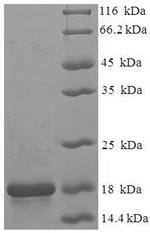Recombinant Macaca fascicularis Frataxin, mitochondrial (FXN) is produced in E. coli and includes the full-length mature protein from amino acids 81 to 210. The protein carries an N-terminal 6xHis-tag to aid in purification, reaching a purity level greater than 90% as determined by SDS-PAGE. This product is strictly for research use only and cannot be used for human or clinical applications.
Frataxin appears to be a mitochondrial protein that helps regulate iron homeostasis and oxidative stress response. Research suggests it plays a critical role in the biogenesis of iron-sulfur clusters, which are essential for various enzymatic processes. Understanding frataxin's function may be crucial for studying mitochondrial pathophysiology and its implications in cellular metabolism and disease mechanisms.
Potential Applications
Note: The applications listed below are based on what we know about this protein's biological functions, published research, and experience from experts in the field. However, we haven't fully tested all of these applications ourselves yet. We'd recommend running some preliminary tests first to make sure they work for your specific research goals.
Based on the provided information, the recombinant Macaca fascicularis Frataxin (FXN) is expressed in E. coli, a prokaryotic system that may not fully support the correct folding of eukaryotic mitochondrial proteins. Frataxin is involved in iron-sulfur cluster biogenesis and requires precise folding for its iron-binding and protein interaction functions. The protein is expressed as the full-length mature protein (81-210aa), which includes the functional domain, but E. coli lacks the mitochondrial environment and potential chaperones needed for native conformation. The N-terminal 6xHis tag may also influence folding. Since activity is unverified, the protein cannot be assumed to be correctly folded or bioactive without experimental validation (e.g., iron-binding assays). While E. coli can sometimes produce functional proteins, the risk of misfolding remains significant for a eukaryotic protein.
1. Protein-Protein Interaction Studies Using His-Tag Pull-Down Assays
The N-terminal 6xHis tag allows for immobilization on nickel-affinity resins to identify binding partners, but if the frataxin is misfolded, it may not interact physiologically with mitochondrial proteins (e.g., iron-sulfur cluster assembly components), leading to non-specific binding or false negatives. The high purity (>90%) reduces background, but results should be interpreted cautiously until folding is confirmed. If correctly folded, this application is valuable for primate-specific studies; otherwise, it may yield misleading data.
2. Antibody Development and Validation
This application is generally suitable. The recombinant frataxin can serve as an immunogen for antibody generation, as antibodies often recognize linear epitopes less dependent on native folding. The high purity and defined region (81-210aa) support consistent immunization and validation in assays like Western blot or ELISA. However, if misfolded, antibodies may not recognize the native frataxin in mitochondrial contexts, so validation against a full-length, correctly folded protein is recommended.
3. Biochemical Characterization and Iron-Binding Studies
This application is appropriate and should be prioritized to assess folding and bioactivity. Techniques like UV-visible spectroscopy can directly test iron-binding properties, providing insights into function. The mature protein region likely contains the functional domain, but activity must be verified experimentally. If misfolded, these studies will characterize an inactive product, but they are essential for initial validation.
4. Comparative Species Analysis in Mitochondrial Function Studies
The recombinant protein can be used for comparative studies, but only if correctly folded and active. If misfolded, comparisons with orthologs in iron-sulfur cluster assembly assays may be invalid. So, folding should be confirmed first to ensure physiological relevance.
Final Recommendation & Action Plan
Given the uncertainty in folding and bioactivity, the priority is to validate the protein's conformation and function through biochemical assays (e.g., iron-binding tests using spectroscopy, circular dichroism for secondary structure, and size-exclusion chromatography for oligomeric state). If active, the protein can be reliably used for interaction studies and comparative analyses; if inactive, focus on applications like antibody development or as a control for biochemical characterization. Always include controls such as native frataxin or orthogonal assays to confirm results, and consider using eukaryotic expression systems if folding issues are detected for functional studies.






